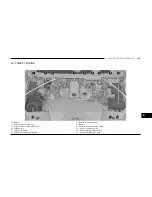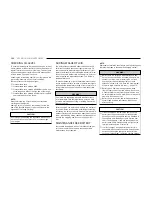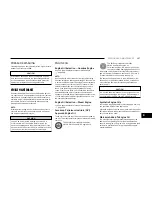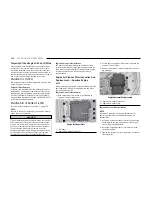
NOTE:
•
It is the owner's responsibility to maintain the proper
level of protection against freezing according to the
temperatures occurring in the area where the
vehicle is operated.
•
Some vehicles require special tools to add coolant
properly. Failure to fill these systems properly could
lead to severe internal engine damage. If any cool-
ant is needed to be added to the system, please
contact a local authorized dealer.
•
Mixing engine coolant types is not recommended
and can result in cooling system damage. If HOAT
and OAT coolant are mixed in an emergency, have
an authorized dealer drain, flush, and refill with OAT
coolant (conforming to MS.90032) as soon as
possible.
Cooling System Pressure Cap
The cap must be fully tightened to prevent loss of
engine coolant (antifreeze), and to ensure that engine
coolant will return to the radiator from the coolant
expansion bottle/recovery tank (if equipped).
The cap should be inspected and cleaned if there is any
accumulation of foreign material on the sealing
surfaces.
NOTE:
Be sure you do not mix the engine coolant system pres-
sure cap with the intercooler system pressure cap.
These caps are not interchangeable.
WARNING!
•
Do not open a hot engine cooling system. Never
add engine coolant (antifreeze) when the engine is
overheated. Do not loosen or remove the cap to
cool an overheated engine. Heat causes pressure
to build up in the cooling system. To prevent scald-
ing or injury, do not remove the pressure cap while
the system is hot or under pressure.
•
Do not use a pressure cap other than the one
specified for your vehicle. Personal injury or engine
damage may result.
Disposal Of Used Coolant
Used ethylene glycol-based coolant (antifreeze) is a regu-
lated substance requiring proper disposal. Check with your
local authorities to determine the disposal rules for your
community. To prevent ingestion by animals or children, do
not store ethylene glycol-based coolant in open containers
or allow it to remain in puddles on the ground, clean up any
ground spills immediately. If ingested by a child or pet,
seek emergency assistance immediately.
Checking Coolant Level — 6.4L Engine
The level of the coolant in the pressurized coolant
bottle should be between the “MIN” and “MAX” range
on the bottle when the engine is cold.
The radiator normally remains completely full, so there is
no need to remove the cap unless checking for coolant
freeze point or replacing engine coolant (antifreeze).
Advise your service attendant of this. As long as the engine
operating temperature is satisfactory, the coolant bottle
need only be checked once a month. When additional
engine coolant is needed to maintain the proper level, it
should be added to the coolant bottle. Do not overfill.
Cooling System Notes
NOTE:
When the vehicle is stopped after a few miles/
kilometers of operation, you may observe vapor coming
from the front of the engine compartment. This is nor-
mally a result of moisture from rain, snow, or high
humidity accumulating on the radiator and being vapor-
ized when the thermostat opens, allowing hot engine
coolant (antifreeze) to enter the radiator.
If an examination of your engine compartment shows
no evidence of radiator or hose leaks, the vehicle may
be safely driven. The vapor will soon dissipate.
•
Do not overfill the coolant expansion bottle.
•
Check the coolant freeze point in the radiator and in
the coolant expansion bottle. If engine coolant (anti-
freeze) needs to be added, the contents of the cool-
ant expansion bottle must also be protected against
freezing.
•
If frequent engine coolant additions are required, the
cooling system should be pressure tested for leaks.
•
Maintain engine coolant concentration at a mini-
mum of 50% OAT coolant (conforming to MS.90032)
and distilled water for proper corrosion protection of
your engine which contains aluminum components.
•
Make sure that the coolant expansion bottle over-
flow hoses are not kinked or obstructed.
•
Keep the front of the radiator clean. If your vehicle is
equipped with air conditioning, keep the front of the
condenser clean.
•
Do not change the thermostat for Summer or Winter
operation. If replacement is ever necessary, install
ONLY the correct type thermostat. Other designs
may result in unsatisfactory engine cooling perfor-
mance, poor gas mileage, and increased emissions.
SERVICING AND MAINTENANCE
299
8
Summary of Contents for CHASSIS CAB 2024
Page 69: ...GETTING TO KNOW YOUR INSTRUMENT PANEL MIDLINE INSTRUMENT CLUSTER GASOLINE 67 3...
Page 71: ...HIGHLINE INSTRUMENT CLUSTER GASOLINE GETTING TO KNOW YOUR INSTRUMENT PANEL 69 3...
Page 75: ...MIDLINE INSTRUMENT CLUSTER DIESEL GETTING TO KNOW YOUR INSTRUMENT PANEL 73 3...
Page 77: ...HIGHLINE INSTRUMENT CLUSTER DIESEL GETTING TO KNOW YOUR INSTRUMENT PANEL 75 3...
Page 357: ......
Page 358: ......


































